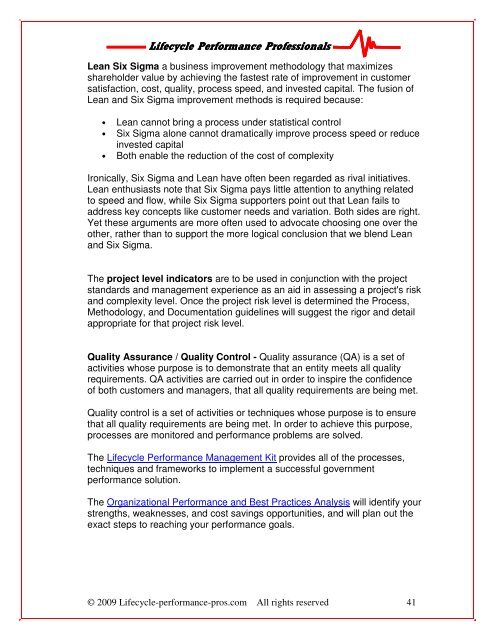Download the Performance Management Fundamentals Guide
Download the Performance Management Fundamentals Guide
Download the Performance Management Fundamentals Guide
You also want an ePaper? Increase the reach of your titles
YUMPU automatically turns print PDFs into web optimized ePapers that Google loves.
Lifecycle Lifecycle <strong>Performance</strong> <strong>Performance</strong> Professionals<br />
Professionals<br />
Lean Six Sigma a business improvement methodology that maximizes<br />
shareholder value by achieving <strong>the</strong> fastest rate of improvement in customer<br />
satisfaction, cost, quality, process speed, and invested capital. The fusion of<br />
Lean and Six Sigma improvement methods is required because:<br />
• Lean cannot bring a process under statistical control<br />
• Six Sigma alone cannot dramatically improve process speed or reduce<br />
invested capital<br />
• Both enable <strong>the</strong> reduction of <strong>the</strong> cost of complexity<br />
Ironically, Six Sigma and Lean have often been regarded as rival initiatives.<br />
Lean enthusiasts note that Six Sigma pays little attention to anything related<br />
to speed and flow, while Six Sigma supporters point out that Lean fails to<br />
address key concepts like customer needs and variation. Both sides are right.<br />
Yet <strong>the</strong>se arguments are more often used to advocate choosing one over <strong>the</strong><br />
o<strong>the</strong>r, ra<strong>the</strong>r than to support <strong>the</strong> more logical conclusion that we blend Lean<br />
and Six Sigma.<br />
The project level indicators are to be used in conjunction with <strong>the</strong> project<br />
standards and management experience as an aid in assessing a project's risk<br />
and complexity level. Once <strong>the</strong> project risk level is determined <strong>the</strong> Process,<br />
Methodology, and Documentation guidelines will suggest <strong>the</strong> rigor and detail<br />
appropriate for that project risk level.<br />
Quality Assurance / Quality Control - Quality assurance (QA) is a set of<br />
activities whose purpose is to demonstrate that an entity meets all quality<br />
requirements. QA activities are carried out in order to inspire <strong>the</strong> confidence<br />
of both customers and managers, that all quality requirements are being met.<br />
Quality control is a set of activities or techniques whose purpose is to ensure<br />
that all quality requirements are being met. In order to achieve this purpose,<br />
processes are monitored and performance problems are solved.<br />
The Lifecycle <strong>Performance</strong> <strong>Management</strong> Kit provides all of <strong>the</strong> processes,<br />
techniques and frameworks to implement a successful government<br />
performance solution.<br />
The Organizational <strong>Performance</strong> and Best Practices Analysis will identify your<br />
strengths, weaknesses, and cost savings opportunities, and will plan out <strong>the</strong><br />
exact steps to reaching your performance goals.<br />
© 2009 Lifecycle-performance-pros.com All rights reserved 41










